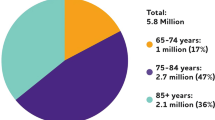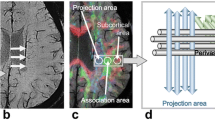Abstract
Purpose
To develop a computer-assisted automated diagnostic system to distinguish among Alzheimer disease (AD), dementia with Lewy bodies (DLB), and other degenerative disorders in patients with mild dementia.
Methods
Single photon emission computed tomography (SPECT) images with injection of N-Isopropyl-p-[123I]iodoamphetamine (IMP) were obtained from patients with mild degenerative dementia. First, datasets from 20 patients mild AD, 15 patients with dementia with DLB, and 17 healthy controls were used to develop an automated diagnosing system based on three-dimensional stereotactic surface projections (3D-SSP). AD- and DLB-specific regional templates were created using 3D-SSP, and critical Z scores in the templates were established. Datasets from 50 AD patients, 8 DLB patients, and 10 patients with non-AD/DLB type degenerative dementia (5 with frontotemporal dementia and 5 with progressive supranuclear palsy) were then used to test the diagnostic accuracy of the optimized automated system in comparison to the diagnostic interpretation of conventional IMP-SPECT images. These comparisons were performed to differentiate AD and DLB from non-AD/DLB and to distinguish AD from DLB. A receiver operating characteristic (ROC) analysis was performed.
Results
The area under the ROC curve (Az) and the accuracy of the automated diagnosis system were 0.89 and 82%, respectively, for AD/DLB vs. non-AD/DLB patients, and 0.70 and 65%, respectively, for AD vs. DLB patients. The mean Az and the accuracy of the visual inspection were 0.84 and 77%, respectively, for AD/DLB vs. non-AD/DLB patients, and 0.70 and 65%, respectively, for AD vs. DLB patients. The mean Az and the accuracy of the combination of visual inspection and this system were 0.96 and 91%, respectively, for AD/DLB vs. non-AD/DLB patients, and 0.70 and 66%, respectively, for AD vs. DLB patients.
Conclusion
The system developed in the present study achieved as good discrimination of AD, DLB, and other degenerative disorders in patients with mild dementia as the commonly performed visual inspection of conventional SPECT images. A combination of visual inspection and this system is helpful in the differential diagnosis of patients with mild dementia.




Similar content being viewed by others
References
Herholz K, Schopphoff H, Schmidt M, Mielke R, Eschner W, Scheidhauer K. Direct comparison of spatially normalized PET and SPECT scans in Alzheimer’s disease. J Nucl Med 2002;43:21–6.
Silverman DH. Brain 18F-FDG PET in the diagnosis of neurodegenerative dementias: comparison with perfusion SPECT and with clinical evaluations lacking nuclear imaging. J Nucl Med 2004;45:594–607.
Ishii K, Minoshima S. PET is better than perfusion SPECT for early diagnosis of Alzheimer’s disease. Eur J Nucl Med Mol Imaging 2005;32:1463–6.
Burdette JH, Minoshima S, Vander Borght T, Tran DD, Kuhl DE. Alzheimer disease: improved visual interpretation of PET images by using three-dimensional stereotaxic surface projections. Radiology 1996;198:837–43.
Bartenstein P, Minoshima S, Hirsch C, Buch K, Willoch F, Mösch D, et al. Quantitative assessment of cerebral blood flow in patients with Alzheimer’s disease by SPECT. J Nucl Med 1997;38:1095–101.
Imabayashi E, Matsuda H, Asada T, Ohnishi T, Sakamoto S, Nakano S, et al. Superiority of 3-dimensional stereotactic surface projection analysis over visual inspection in discrimination of patients with very early Alzheimer’s disease from controls using brain perfusion SPECT. J Nucl Med 2004;45:1450–7.
Ishii K, Kono AK, Sasaki H, Miyamoto N, Fukuda T, Sakamoto S, et al. Fully automatic diagnostic system for early- and late-onset mild Alzheimer’s disease using FDG PET and 3D-SSP. Eur J Nucl Med Mol Imaging 2006;33:575–83.
Kono AK, Ishii K, Sofue K, Miyamoto N, Sakamoto S, Mori E. Fully automatic differential diagnosis system for dementia with Lewy bodies and Alzheimer’s disease using FDG-PET and 3D-SSP. Eur J Nucl Med Mol Imaging 2007;34:1490–7.
Minoshima S, Frey KA, Koeppe RA, Foster NL, Kuhl DE. A diagnostic approach in Alzheimer’s disease using three-dimensional stereotactic surface projections of fluorine-18-FDG PET. J Nucl Med 1995;36:1238–48.
McKhann G, Drachman D, Folstein M, Katzman R, Price D, Stadlan E. Clinical diagnosis of Alzheimer’s disease: report of the NINCDS-ADRDA Work Group under the auspices of Department of Health and Human Services Task Force on Alzheimer’s Disease. Neurology 1984;34:939–44.
McKeith IG, Galasko D, Kosaka K, Perry EK, Dickson DW, Hansen LA, et al. Consensus guidelines for the clinical and pathologic diagnosis of dementia with Lewy bodies (DLB): report of the consortium on DLB international workshop. Neurology 1996;47:1113–24.
Neary D, Snowden JS, Gustafson L, Passant U, Stuss D, Black S. Frontotemporal lobar degeneration: a consensus on clinical diagnostic criteria. Neurology 1998;51:1546–54.
Litvan I, Agid Y, Calne D, Campbell G, Dubois B, Duvoisin RC, et al. Clinical research criteria for the diagnosis of progressive supranuclear palsy (Steele-Richardson-Olszewski syndrome): report of the NINDS-SPSP international workshop. Neurology 1996;47:1–9.
Sasaki H, Ishii K, Kono AK, Miyamoto N, Fukuda T, Shimada K. Cerebral perfusion pattern of idiopathic normal pressure hydrocephalus studied by SPECT and statistical brain mapping. Ann Nucl Med 2007;21:39–45.
Ishii K, Yamaji S, Mori E. Cerebellar metabolic reduction in Alzheimer’s disease and data normalization. J Nucl Med 1998;39:375–6.
Ishii K, Imamura T, Sasaki M, Yamaji S, Sakamoto S, Kitagaki H, et al. Regional cerebral glucose metabolism in dementia with Lewy bodies and Alzheimer’s disease. Neurology 1998;51:125–30.
Ishii K, Sasaki M, Matsui M, Sakamoto S, Yamaji S, Hayashi N. A diagnostic method for suspected Alzheimer’s disease using H(2)15O positron emission tomography perfusion Z score. Neuroradiology 2000;42:787–94.
Herholz K, Salmon E, Perani D, Baron JC, Holthoff V, Frölich L, et al. Discrimination between Alzheimer dementia and controls by automated analysis of multicenter FDG PET. Neuroimage 2002;17:302–16.
Matsuda H, Mizumura S, Nagao T, Ota T, Iizuka T, Nemoto K, et al. Automated discrimination between very early Alzheimer disease and controls using an easy Z-score imaging system for multicenter brain perfusion single-photon emission tomography. AJNR Am J Neuroradiol 2007;28:731–6.
Mosconi L, Tsui WH, Herholz K, Pupi A, Drzezga A, Lucignani G, et al. Multicenter standardized 18F-FDG PET diagnosis of mild cognitive impairment, Alzheimer’s disease, and other dementias. J Nucl Med 2008;49:390–8.
Minoshima S, Foster NL, Sima AAF, Frey KA, Albin RL, Kuhl DE. Alzheimer’s disease versus dementia with Lewy bodies: cerebral metabolic distinction with autopsy confirmation. Ann Neurol 2001;50:358–65.
Ishii K, Hosaka K, Mori T, Mori E. Comparison of FDG-PET and IMP-SPECT in patients with dementia with Lewy bodies. Ann Nucl Med 2004;18:447–51.
Ishii K, Sakamoto S, Sasaki M, Kitagaki H, Yamaji S, Hashimoto M, et al. Cerebral glucose metabolism in patients with frontotemporal dementia. J Nucl Med 1998;39:1875–8.
Diehl-Schmid J, Grimmer T, Drzezga A, Bornschein S, Riemenschneider M, Förstl H, et al. Decline of cerebral glucose metabolism in frontotemporal dementia: a longitudinal 18F-FDG-PET-study. Neurobiol Aging 2007;28:42–50.
Minoshima S, Frey KA, Foster NL, Kuhl DE. Preserved pontine glucose metabolism in Alzheimer disease: a reference region for functional brain image (PET) analysis. J Comput Assist Tomogr 1995;19:541–7.
Hosaka K, Ishii K, Sakamoto S, Mori T, Sasaki M, Hirono N, et al. Voxel-based comparison of regional cerebral glucose metabolism between PSP and corticobasal degeneration. J Neurol Sci 2002;199:67–71.
Acknowledgments
The authors thank Mr. Shuya Miki (Nihon Medi-Physics, Tokyo, Japan) for providing and improving the iSSP program, which uses the 3D-SSP program and was dedicated to this automated method.
Author information
Authors and Affiliations
Corresponding author
Rights and permissions
About this article
Cite this article
Ishii, K., Kanda, T., Uemura, T. et al. Computer-assisted diagnostic system for neurodegenerative dementia using brain SPECT and 3D-SSP. Eur J Nucl Med Mol Imaging 36, 831–840 (2009). https://doi.org/10.1007/s00259-008-1051-3
Received:
Accepted:
Published:
Issue Date:
DOI: https://doi.org/10.1007/s00259-008-1051-3




